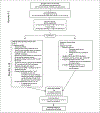Exploratory Analysis of the Impact of an mHealth Medication Adherence Intervention on Tacrolimus Trough Concentration Variability: Post Hoc Results of a Randomized Controlled Trial
- PMID: 32506922
- PMCID: PMC7814696
- DOI: 10.1177/1060028020931806
Exploratory Analysis of the Impact of an mHealth Medication Adherence Intervention on Tacrolimus Trough Concentration Variability: Post Hoc Results of a Randomized Controlled Trial
Abstract
Background: Medication nonadherence is a leading cause of late allograft loss in kidney transplantation (KT). Tacrolimus trough coefficient of variation (CV), measured using the coefficient of variation, is strongly correlated with acute rejection, graft function, and graft loss.
Objective: The objective of this study was to determine if this mobile health (mHealth) intervention aimed at improving medication adherence in a nonadherent KT population would affect high intrapatient tacrolimus variability.
Methods: A 6-month, prospective, parallel-arm, randomized controlled clinical trial was conducted to determine the effects of an mHealth intervention on tacrolimus CV. Intervention arm participants utilized an electronic medication tray and an mHealth app to monitor home-based adherence. Tailored motivational reinforcement messages were delivered to promote competence for adherence. Tacrolimus CV was measured using a 12-month rolling average, assessed at monthly intervals (6-month intervention period and 6 months after completion of the study); 80 were included, 40 in each arm.
Results: At baseline, tacrolimus CV was similar between arms (37% ± 15% intervention, 37% ± 13% control, P = 0.894). Patients randomized to the intervention had a significant reduction in mean 12-month tacrolimus CVs (P = 0.046) and a significant improvement in the proportion achieving low tacrolimus CV (tacrolimus CV < 40%; P = 0.001), as compared with the control arm.
Conclusion and relevance: High tacrolimus CV is a risk factor for acute rejection and graft loss; these results offer the potential promise of improved medication adherence and clinical outcomes through the use of innovative technology.
Keywords: Smartphone Medication Adherence Saves Kidneys; coefficient of variation; end-stage renal disease; estimated glomerular filtration rate; kidney transplantation; mobile health; randomized controlled trial; standard of care; time weighted coefficient of variation.
Conflict of interest statement
Declaration of Conflicting Interests
The authors declared no potential conflicts of interest with respect to the research, authorship, and/or publication of this article.
Figures


References
-
- Manninen DL, Evans RW, Dugan MK. Work disability, functional limitations, and the health status of kidney transplantation recipients posttransplant. Clin Transpl. 1991:193–203. - PubMed
-
- Wolfe RA, Ashby VB, Milford EL, et al. Comparison of mortality in all patients on dialysis, patients on dialysis awaiting transplantation, and recipients of a first cadaveric transplant. N Engl J Med. 1999;341:1725–1730. - PubMed
-
- Laupacis A, Keown P, Pus N, et al. A study of the quality of life and cost-utility of renal transplantation. Kidney Int. 1996;50:235–242. - PubMed
-
- Neipp M, Karavul B, Jackobs S, et al. Quality of life in adult transplant recipients more than 15 years after kidney transplantation. Transplantation. 2006;81:1640–1644. - PubMed
-
- Lamb KE, Lodhi S, Meier-Kriesche HU. Long-term renal allograft survival in the United States: a critical reappraisal. Am J Transplant. 2011;11:450–462. - PubMed
Publication types
MeSH terms
Substances
Grants and funding
LinkOut - more resources
Full Text Sources
Medical

